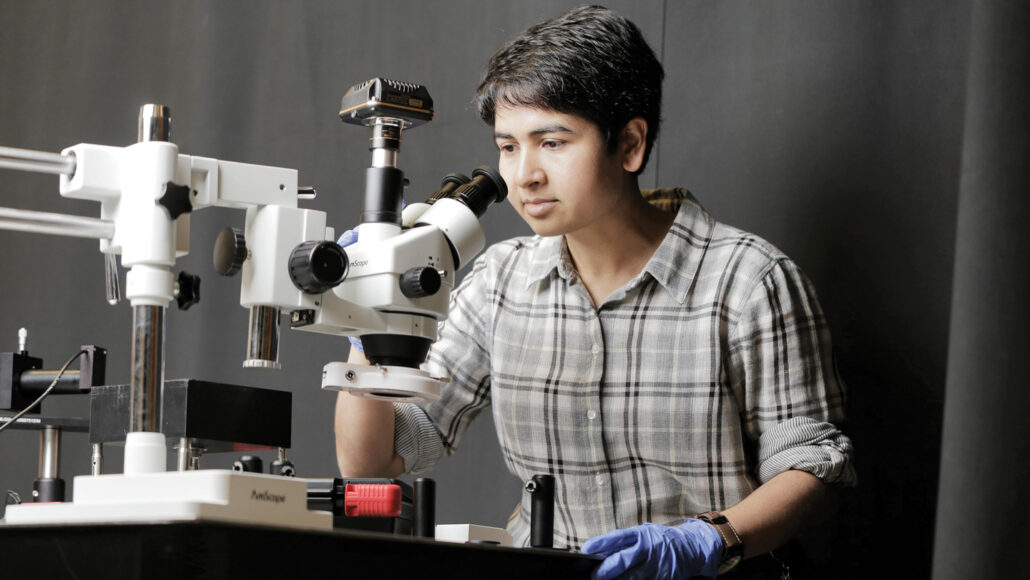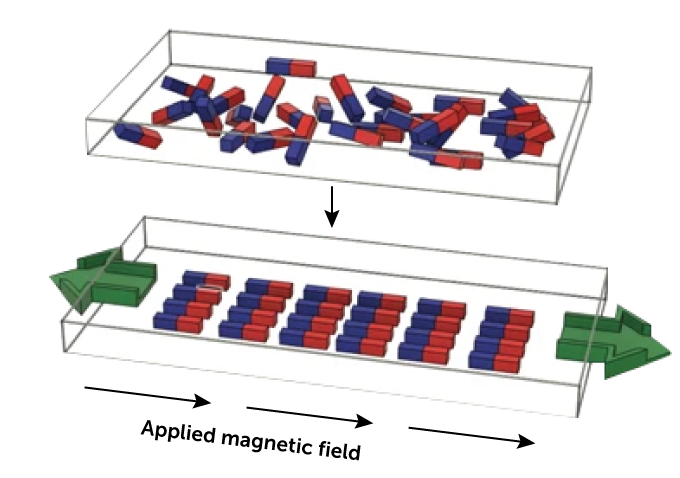Nanobots can now enter brain cells to spy on what they’re doing
One day, advanced versions may be able to detect diseases — and possibly treat them

It’s Deblina Sarkar’s goal to one day develop miniature machines that could help treat neurological disorders, such as Alzheimer’s disease and Parkinson’s disease.
Jimmy Day, MIT Media Lab
Share this:
- Share via email (Opens in new window) Email
- Click to share on Facebook (Opens in new window) Facebook
- Click to share on X (Opens in new window) X
- Click to share on Pinterest (Opens in new window) Pinterest
- Click to share on Reddit (Opens in new window) Reddit
- Share to Google Classroom (Opens in new window) Google Classroom
- Click to print (Opens in new window) Print
By Nikk Ogasa
Deblina Sarkar has big dreams for the little machines that she makes. Some of her ultra-tiny electronic devices are smaller than a mote of dust. And her dreams? They’re so big that they may one day be able to save your mind.
Sarkar works at the Massachusetts Institute of Technology in Cambridge. Her goal is to one day put those itsy bitsy devices inside the cells, or neurons, of human brains. “I’m probably working day and night on my research,” she says. “There is an urgent problem at hand.”
She’s referring to neurological disorders that degrade the minds of millions of people worldwide. These include Alzheimer’s disease and Parkinson’s disease. Sarkar wants to put nanodevices into our brains to detect these disorders — and eventually reverse them. In the lab, she’s already working to make that dream a reality.
Her research team is developing devices to work in living cells. They also are creating “neuromorphic” computing devices. These are inspired by the human brain and nervous system. After all, Sarkar explains, the brain is efficient at quickly processing information.
Consider the Cell Rover
Her group’s most innovative device may be the Cell Rover. A tiny, flat antenna, this rover can transmit a signal from inside of a cell — without harming it.
In one study last year, Sarkar and her colleagues placed a Cell Rover into a frog-egg cell. Using magnetic fields, they gently nudged the device into the egg. Once it was safely inside, the researchers activated a different magnetic field. That caused molecules in the nanodevice to vibrate.
Those vibrations didn’t hurt the cell. They just changed the magnetic field of the Cell Rover itself. A receiver outside the egg detected the altered magnetic field of the quivering rover. In this way, the device had been able to communicate with the outside world.

One of Cell Rover’s strengths is that its design is fairly simple, says José Plaza. “It has to be as simple as possible,” he explains, to limit the chance that problems will develop. Plaza works at the Institute of Microelectronics of Barcelona in Spain. A physicist, he develops computer chips that can fit inside cells.
Think of the MIT nanomachine as being similar to a rover on Mars, he says. If the Mars rover develops a problem, there’s no mechanic on the Red Planet to fix it. The same challenge exists inside a cell, he points out. For this reason, a simple device that won’t break down is a safer bet.
Imagining rover rescues
The MIT Cell Rover could be outfitted with sensors to detect certain molecules inside cells. Those nanosensors could be films that grab onto certain proteins or other cell-made molecules. Detecting a target molecule would give scientists data pointing to processes that are going on inside of cells.
For example, the Cell Rover might be used with sensors to spot misfolded proteins in the brain, Sarkar says. Those misfolded proteins might be early signs of Alzheimer’s disease. Today, the only sign of Alzheimer’s in a living person is memory loss. And by the time someone’s memories are vanishing, it’s already too late to reverse the damage, Sarkar says.
The frog-egg cells into which Sarkar’s team injected Cell Rovers are some 10 times the size of human brain cells, Plaza notes. To use Cell Rovers inside our cells, he says, the MIT team will need to show that far smaller versions will also work.
One day, Sarkar hopes that Cell Rovers could be used with nanodevices to harvest energy from cells. Or they could be used to electrically stimulate cells. That would open the door for new types of brain electrodes and ultra-tiny pacemakers that are much smaller than any available today.
She can even imagine fleets of remotely controlled rovers that might conduct surgeries — without a need to cut open the brain. These fleets might detect a small tumor growing in the brain, for example, and then kill it.
Eventually, Sarkar hopes to insert nanodevices between human neurons. That could boost our mind’s computing speed. Our brains are remarkable, she says, but adds “we could be better than what we are.”






